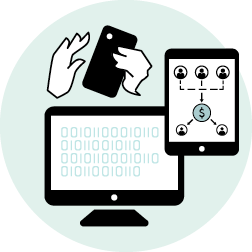In news that probably won’t surprise you, we’re all working harder than ever.
Thanks to the pandemic and the need for safe, flexible shopping and payments, more than 100 million consumers shifted into digital-first channels last year, according to PYMNTS.com, accelerating the move from brick-and-mortar shopping.
Consumers may have moved to digital shopping out of caution, but because of its convenience, online shopping will remain a preference among recent converts and habitual users alike. 83% of consumers surveyed by PYMNTS.com say they will stay with some or all their digital habits in the future. And other research shows that nearly half of consumers say they are now more influenced by convenience than price and will sacrifice cost savings for convenience.
The shift to online purchasing and payments doesn’t just apply to B2C transactions; it’s evident in the B2B world, too. 74% of B2B buyers research at least half of their work-related purchases online, and 30% complete at least half of their work-related purchases online, according to Forrester. In just one year, the share of B2B companies that make more than 90% of their payments electronically rose by 12 percentage points, up to about a quarter of the total B2B payments value in 2020, new research shows.
Nowadays, convenience – not cash – is king among buyers. What does that mean for sellers, B2B and B2C alike?
First, and perhaps most important, offer multiple payment options to meet a variety of customer needs. One study found that multiple ways to pay can increase a business’s revenue by nearly 30%. Those that accept 4 or more payment options bring in 7 times more annual revenue than those offering fewer options.
In addition to credit and debit cards, payment by ACH is becoming more and more popular in the B2B space. In 2020, B2B use of ACH for vendor and supply chain payments rose almost 15%, to 1.2 billion transactions. Accelerated use of ACH among businesses continued a shift that started two years ago, when for the first time fewer than half of B2B payments were made by check, a study by the Association for Financial Professionals found.
Second, make checkout as easy as possible. Somewhere between 57% and 84% of shopping carts are abandoned before a customer makes a purchase, various studies say. The more work you force customers to do, the less likely they are to convert.
The principles of web navigation that apply to the rest of your site also apply to your checkout. Make it effortless for customers to save – and later return to – their carts, and help them find their way through your site by offering logical, intuitive navigation between your checkout and product pages.
In addition, simplify your checkout forms. Forms that are spread over multiple pages, without a checkbox to select the same billing and shipping address, or with ambiguous form fields can make checkout time-consuming and complicated.
Third, optimize your mobile website. What is more convenient than being able to purchase anytime, anyplace using a smartphone or tablet? Nothing, really. And mobile commerce sales reflect that reality. U.S. retail sales conducted from mobile devices grew 41% in 2020 and are expected to grow another 15% in 2021, reaching $359 billion, according to emarketer.com. If your site isn’t mobile-friendly, you will lose business – it’s as simple as that.
Websites using a mobile-first approach leverage the unique aspects of mobile devices (screen size, touch screens, vertical orientations, etc.). Text size, navigation, link placement, and fast page loading all are important. So is content that automatically adjusts so users don’t have to rotate their screens to read it.
Mobile shopping cart abandonment rates are at the top end of the range, and ecommerce brands lose $18 billion in sales as a result. On the other hand, checkout optimization can increase conversions by 36%. So you need to pay attention to your mobile checkout pages, too, to make sure they’re optimized.
Fourth, if you need to invoice customers, make that fast and easy, too, with electronic invoicing and text-to-pay. Though the volume of commercial checks has dropped by half in the last decade, 3.7 billion checks still were collected in 2020, the Federal Reserve says. 81% of businesses continue to use paper checks in some form, but only 40% are satisfied with them, according to a PYMNTS.com research report. So it’s not surprising that 46% of accounts payable professionals would appreciate e-invoice solutions. Enabling customers to self-pay online is quick, efficient, and secure.
As is text-to-pay. With text-to-pay, a business sends a notification via text when an invoice payment is due. Customers authorize the payment with a simple reply to the text on a smartphone. They no longer need to write a check or call a business to make a payment, and it’s even easier than paying online. Considering that Americans check their phones 262 times a day on average, recent statistics say, giving people a way to pay via text puts our obsession with smartphones to good use.
Convenient Payment Options Benefit Sellers, Too
Finally, though digital payments offer maximum convenience to customers, they’re good for business, too. In addition to increasing sales, benefits to sellers include improved cash flow thanks to faster payments, reduced administrative costs through the addition of automated processes and elimination of paper invoices, and increased customer satisfaction and retention.
In the end, convenient payments can offer significant competitive advantage, particularly for small and mid-size businesses. For example, one survey reported that 35% of customers want to pay by text message, but only 4% of small businesses offer it as an option. Implementing convenient digital payment options is a small price to pay for a large potential return.
With MerchantE Invoice, you can offer customers their choice of payment method, including ACH, as well as the option to pay-by-text!




